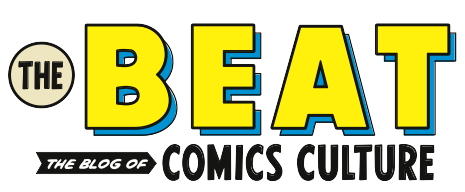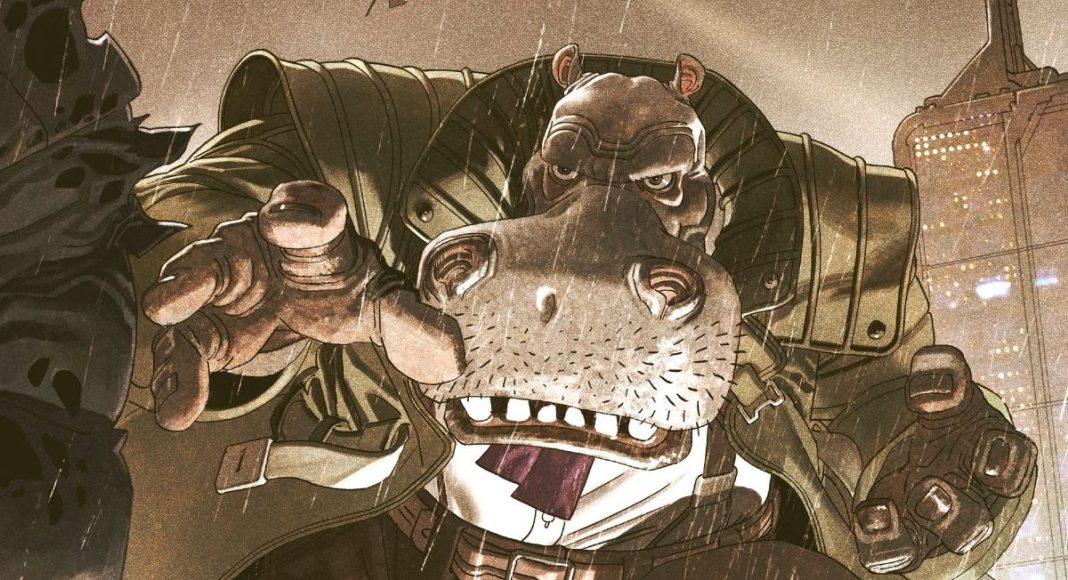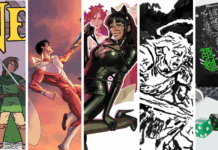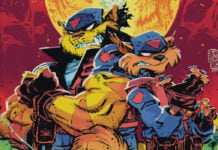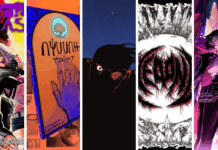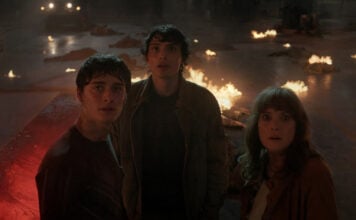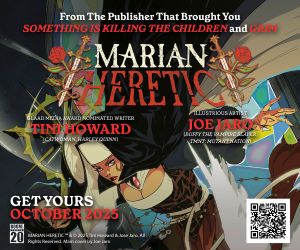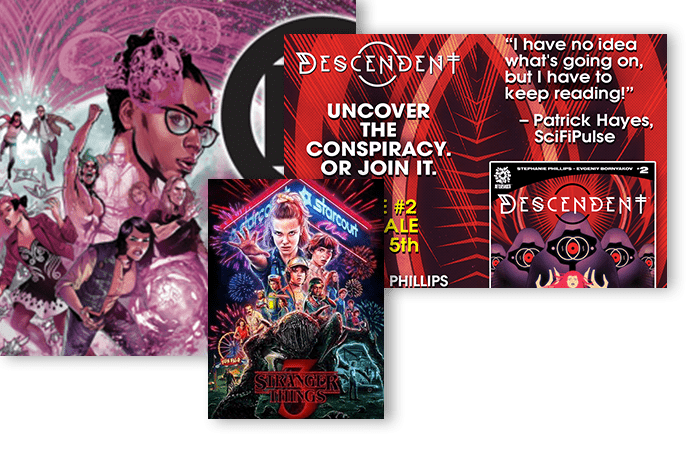In 2002, Hip Flask #1 introduced us to the world of the Elephantmen. Genetically engineered, indoctrinated human-animal hybrids built for war and “rehabilitated” to exist in a world that hates and fears them.
Written and created by Richard Starkings (with initial assistance from Joe Casey) and gloriously rendered by José Ladrönn, Hip Flask was planned as a five-issue series, but the release timetable stretched a tad. Hip Flask #2 came out in 2003….#3 in 2005….#4 in 2012….and then nothing.
At times, it seemed that the dramatic time-travelling story of hippo-hybrid Hip Flask might never see completion.
And yet.
In 2006, Starkings, with artists Moritat and Axel Medellin, released Elephantmen #1, a prequel to Hip Flask set a mere handful of years before that story. Starkings further fleshed out his pulp science fiction universe, drawing critical acclaim. Since then, there have been around a hundred issues (plus the odd mini-series) of Elephantmen at multiple publishers (Image, Comixology Originals, Dark Horse). But the timeline was always BEFORE – never AFTER – the events of Hip Flask.
Now, thirteen years later, the conclusion has arrived. And on Kickstarter, no less.
Beat contributing writer Dean Simons speaks with Richard Starkings about the winding journey of Hip Flask, his series, and the future of the Elephantmen saga.
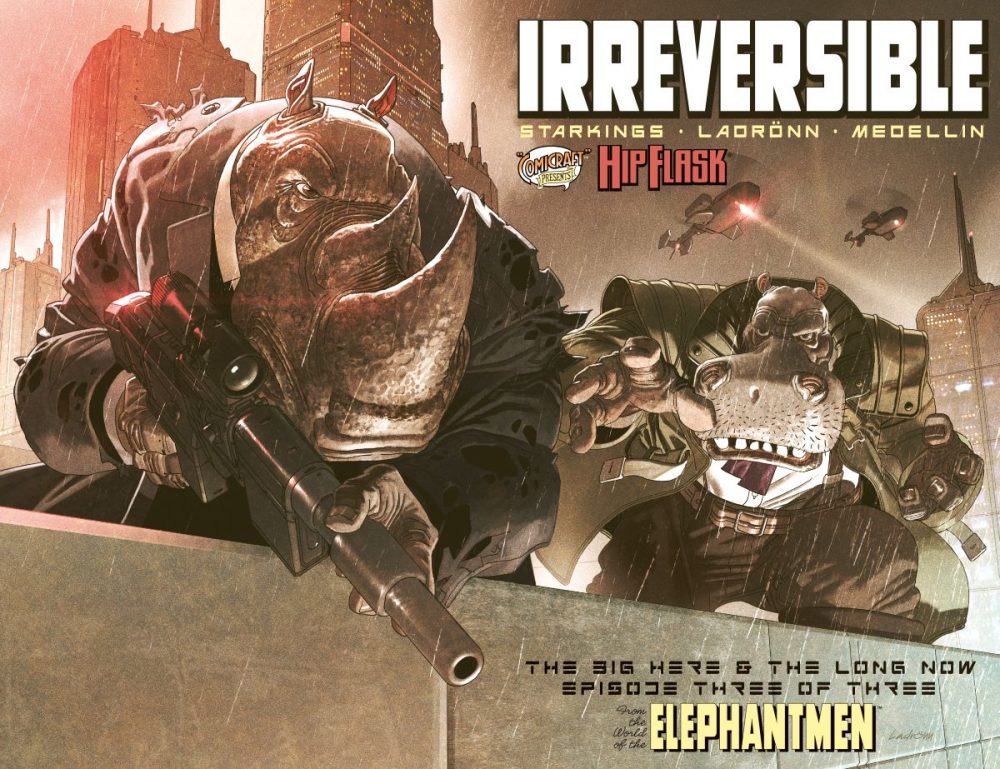
DEAN SIMONS: Can you tell us about Hip Flask? Where did the character come from, how did he creatively evolve, and what was his role in your evolution as a writer and publisher?
RICHARD STARKINGS: Hip originally came into being nearly thirty years ago as a kind of Comicraft mascot for our then-fledgling line of fonts, www.comicbookfonts.com. I had talked to both Bob Harras, at Marvel Comics, and Jim Lee, at Wildstorm Productions, about using the X-Men or WILDC.A.T.S to promote our fonts, but neither one could really figure out what kind of license I’d need to do so! Ultimately, I decided to create my own characters that would feature in one-page comic strips or cover homages. The very first one was drawn by Sergio Aragones of MAD Magazine fame! We had other pieces drawn by several top comic book artists, including Brian Bolland, Chris Bachalo, Ian Churchill, Joe Madureira, and Jae Lee!
Because I worked for several years as an editor and writer for Marvel UK at the beginning of my career, developing the character was second nature to me. Self-publishing and owning the characters I created was inevitable because 2000AD stalwarts John Wagner and Alan Grant had drilled into me how much they regretted giving up the rights to characters they had created. I was also a big fan of Love and Rockets and Cerebus when I was younger, and self-publishing was slowly becoming The Thing To Do.
SIMONS: You’ve had a long working relationship with José Ladrönn – how did you two meet? How did you convince him to do the Hip Flask series?
STARKINGS: I was working on Marvel’s Cable series, first with Jeph Loeb and Ian Churchill and then with Joe Casey and José Ladrönn. José wanted a more European look to the lettering on Cable, so we created a Ladrönn font especially for his run. José was very happy and drew me a Hip Flask pinup—as a thank you.
Later, Joe and I visited José down in San Diego and I discovered that he and I had a lot of influences in common — Alien, Blade Runner, Ghost in the Shell and even Doctor Who and The Tomorrow People, which he’d seen on Mexican TV when he was growing up. He told me how much he’d enjoyed drawing Hip Flask and that he would love to draw a whole story for me. I asked him if he’d be interested in drawing a four issue series and he agreed!
SIMONS: The first couple issues of the Hip Flask series you partnered with Joe Casey, how did that happen, what did you learn, and when did you feel confident enough to become sole writer?
STARKINGS: Joe had quit Cable after writing it for two years; it was his first big break in comics and led to much more. José was exhausted by the monthly schedule and had agreed to draw The Inhumans limited series for Carlos Pacheco. I had a story mapped out, but at that time, I didn’t feel confident that I could write in an American style. Joe was keen to continue working with José and agreed to script the series. However, it became clear to me early on that we were pulling in slightly different directions. I wrote a full “camera” script for José and I pasted together some cityscapes and alleyway shots he had drawn in Cable to show him the kind of mood and direction I was looking for, and I also asked him for widescreen panels so that the story had a much more cinematic style than he had been doing for Marvel.
Originally I had planned for the story that appeared in issue #2 to be the first issue but José kept asking me about the Origin of the Elephantmen — he wanted to know who had created them, and what were they created for! So I told him about Nikken and MAPPO and he said he wanted to illustrate that first!
Our first year working together was more like doing pre-production work on a film! All the material he generated before we even published issue #1 is featured in the Behind the Scenes book Unhuman: The Elephantmen Art of Ladrönn.
So there was a YEAR before José had pages for Joe to script, and during that time, I had become attached to some of the dialogue I had written, so the final version was perhaps 50% my script and 50% Joe’s. When José finished issue #2 after another long year, I was writing 75% of the script, and before we started on #3, Joe agreed that it was best that I script the rest of the series myself. What I learned really was that I had a pretty clear idea of what I wanted in each issue, and micromanaging Joe was counterproductive.
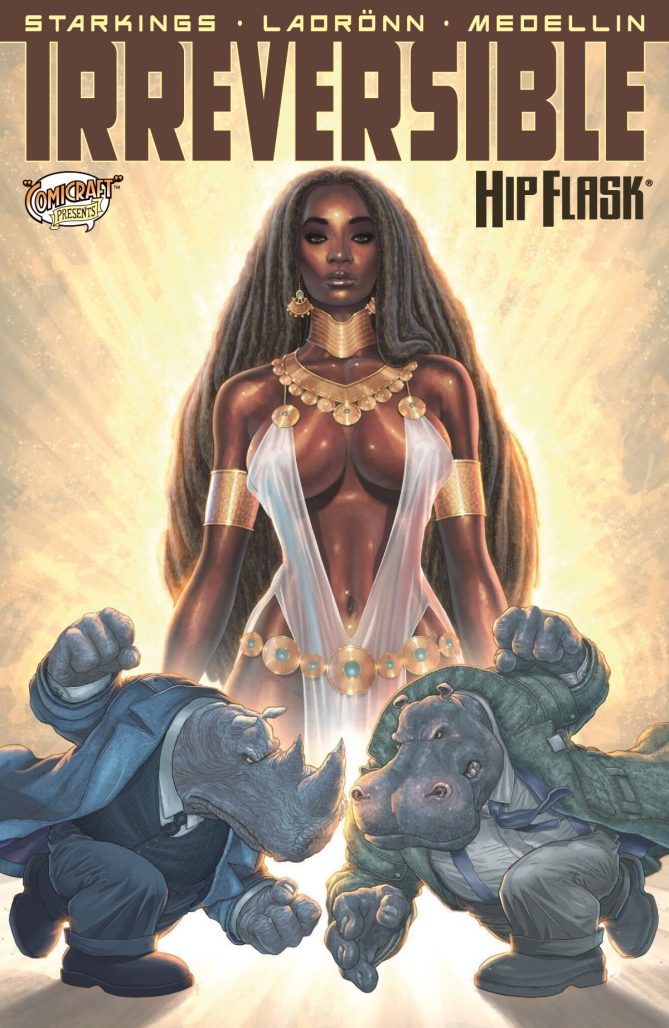
SIMONS: Between issues of the Hip Flask series, there have been in the region of a hundred issues of Elephantmen and other spinoff miniseries. How did those come to be?
STARKINGS: Both Erik Larsen and Eric Stephenson had seen Hip Flask and invited me to bring the series to Image Comics as a monthly. I told them there was no way José would be able to draw a monthly series, and they suggested finding another artist. In my head, I had imagined that a series would be a sequel to the Hip Flask story we were doing and said as much to Joe Casey when we were having pizza together one night. “I have to wait for José to finish,” I had said. “No you don’t,” said Joe, without taking his eyes off the TV screen in the restaurant. “Oh.” I thought, “No, I don’t…”
Moritat came to me via Steve Seagle, who had asked me to publish Solstice for him. Moritat and I got along really well, and he sent me some sketches of Hip, Horn, and Sahara, and it became obvious to me that he was the perfect artist to launch the monthly series. When Moritat was burned out, Axel Medellin appeared with samples at San Diego Comic-Con, and he has been on the series ever since.
So Elephantmen has been ALL prequel to Hip Flask, and it has been a lot of fun creating back story for all the characters. Back story that plays out like a series finale in the Hip Flask five-issue series.
SIMONS: Has much of the core story of the Hip Flask miniseries been changed by the long hiatuses between each issue? Has the Elephantmen series and your own evolution as a writer had much impact?
STARKINGS: Very little. I plotted the entire series out 25 years ago and the ending and story beats have never changed. In this new issue, ‘Irreversible’ there are some flashbacks to moments in the Elephantmen series that long-time readers will recognise and hopefully relish, and there are references to characters and incidents from Elephantmen in the dialogue in both issues #4 and #5, but the story is exactly as I wrote it 25 years ago.
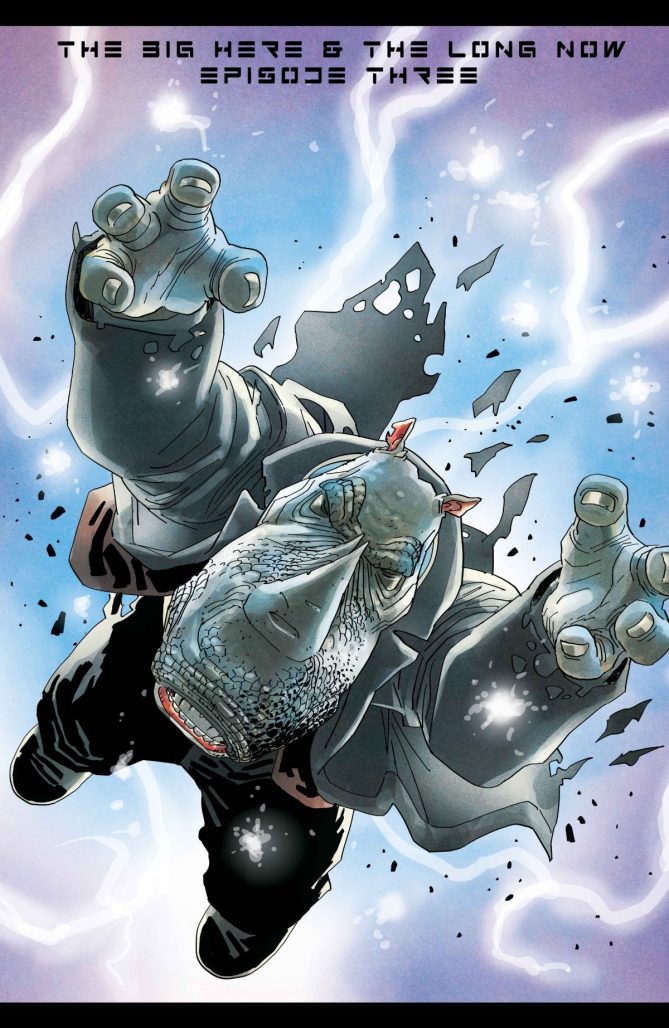
SIMONS: What has been Ladrönn’s role in the story and continued evolution of the Elephantmen universe beyond the Hip Flask limited series?
STARKINGS: When we launched Elephantmen, José committed to illustrating covers for the series, and they were GORGEOUS. Unfortunately, after twelve issues, I realised he wasn’t able to keep up and I hired Boo Cook, a terrific Judge Dredd artist, to take over. Nevertheless, those illustrations of Ebony Hide, Tusk — and many other characters — were essential in setting the tone for the series, which helped attract great artists like Boo, Moritat, Kevin Eastman, Chris Bachalo, Marian Churchland and Nick Bradshaw to the series. Chris Burnham recently told me that his story in issue #9 basically opened doors for him that led to his significant career in comics.
SIMONS: Ladrönn has been quite meticulous with his process on the comic, with extensive hiatuses between each issue. Where has he been?
STARKINGS: It was very clear to me early on that what José really wanted to do was work with Alejandro Jodorowsky, as had his heroes, Moebius and Juan Giménez. Once Jodorowsky had seen José’s work on Hip Flask and they had started working together, I realised that I’d be playing a waiting game to get Hip Flask finished. To that end, I asked José if he would work with Elephantmen regular artist, Axel Medellin, to colour this last issue so that it could be completed while José was working on Sons of El Topo. He agreed.
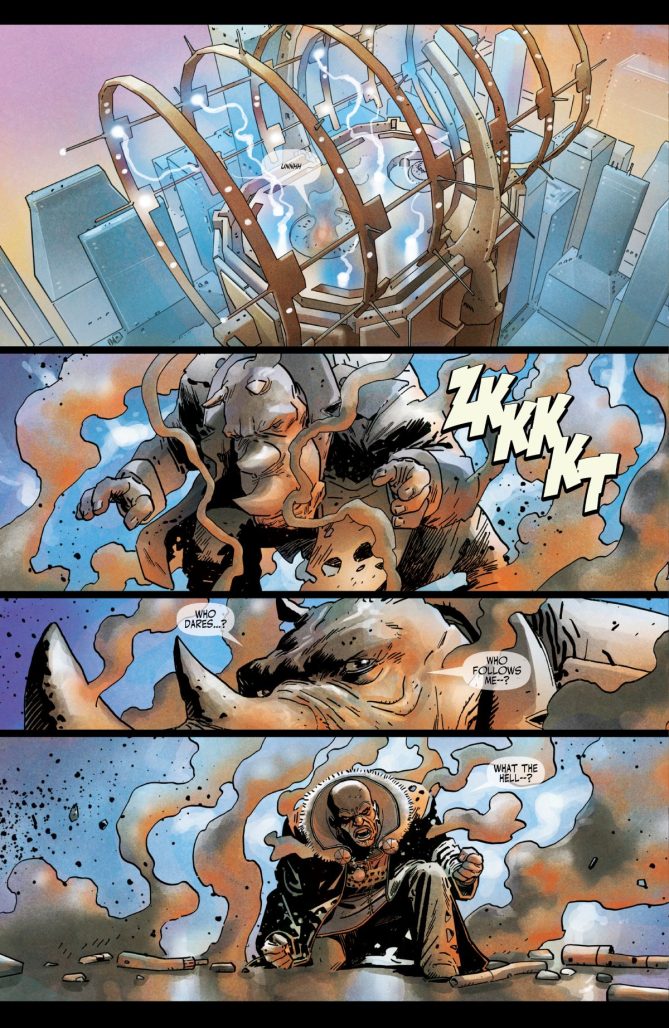
SIMONS: Elephantmen and Hip Flask have also been on quite a publishing journey. I believe you were initially self-published, then joined Image, and since then, you have moved from home to home. How has it been to return to completely self-publishing?
STARKINGS: The best Image Comics creators tend to BE self-publishers. Look at Robert Kirkman. When self-publishers take their projects to Image, they know exactly what they’re giving up when they do so. Publishing is a LOT of work, and there is a LOT of expense. The real fun part is MAKING comics. I would not have been able to publish 90 issues of Elephantmen at Image or the following 20 issues of Elephantmen 2261 at Comixology Originals as a self-publisher. Both Image and Comixology allowed me to retain creator ownership of the series, and I still control all the media rights. I’m very grateful to Erik, and then to Chip Mosher and David Steinberger at Comixology, for giving me safe harbours for Elephantmen over the last 20 years.
SIMONS: The Elephantmen saga has been circling this moment for over twenty years, acting as a prequel to the events in Hip Flask. Have you ever been tempted to completely bypass the miniseries to continue the story post the year 2262 and free yourself from that constraint?
STARKINGS: No, never. Some major characters don’t make it past this issue, so I didn’t want sequel stories that spoiled the ending! However, I will be re-scripting the series for its eventual collection. Joe Casey helped me out immensely back in the day, but I want to go back and make the script completely my own.
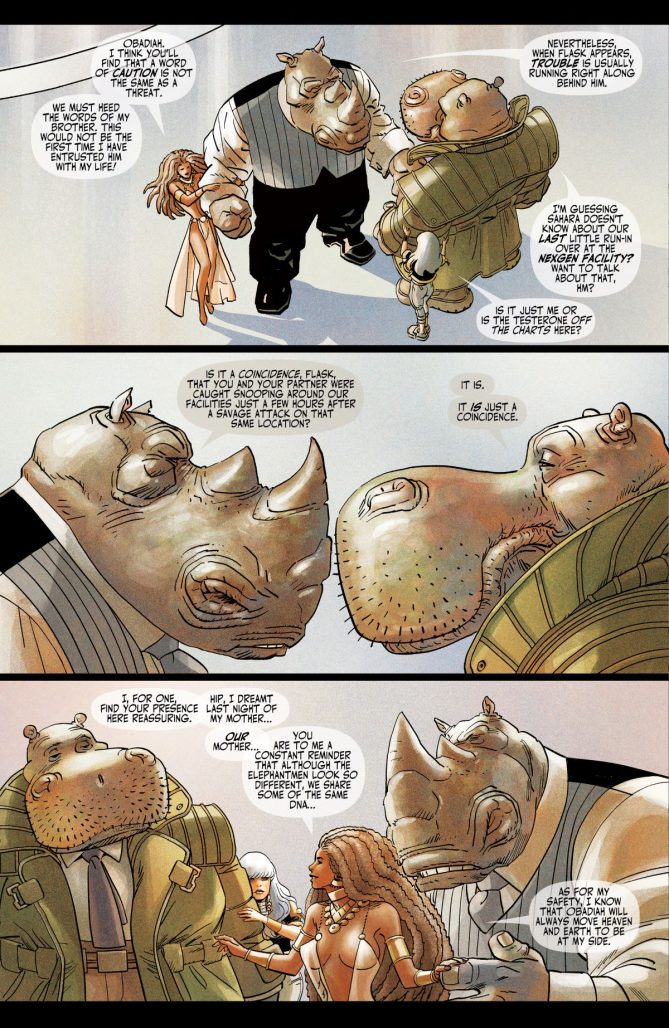
STARKINGS: I’m not sure I knew when the end was in sight but, very recently, I was asked to send a selection of Elephantmen books to a director with a view to him pitching a TV series. I realised I could send him the COMPLETE HIP FLASK story in pdf form and I felt a sudden sense of calm and accomplishment. Having that to send along with my favourite more recent Elephantmen stories – Memories of the Future, The Death of Shorty, and Theo Laroux Meets The Elephantmen was very satisfying.
SIMONS: Is this the end of the Elephantmen story, or do you feel there is more left in the tank?
STARKINGS: Oh, there’s a LOT left in the tank! Axel and I have already finished four issues that follow on from Hip Flask, which will appear in the next year or so on the Kickstarter platform.
SIMONS: This is your third Kickstarter campaign – what first convinced you to do crowdfunding? Has the third go-round been much easier?
STARKINGS: Kickstarter and Print On Demand weren’t available to me when I launched Hip Flask but I feel confident that I’d have used both to launch the series if I was doing so now. It might not have the reach that some of the bigger independent publishers have, but it allows you far more control.
It gets easier to put together each campaign, but they are very time-consuming and require a lot of resources. I do recommend it as a way of retaining creative control over your comics.
SIMONS: For anyone who missed the Kickstarter, how will they be able to pick up the books?
STARKINGS: Don’t miss the Kickstarter! HA! We made some copies of our first Kickstarter, Elephantmen: Yvette, available as Add-Ons part of this new campaign, and a handful of copies of the Parliament of Rooks Kickstarter are also available with Hip Flask #5, too. Nevertheless, I don’t plan on making them available anywhere else for the foreseeable future. I suggest backers buy retailer packs and post some on eBay! I don’t have the time to do that, and I only go to two shows a year, San Diego and Thought Bubble. We do not print many extras over and above the amount ordered by Kickstarter supporters! I don’t think people consider this — comic books take up a lot of storage space!
Hip Flask #5, along with all the prior issues of the miniseries and Elephantmen, is available to order in print and digital via Kickstarter until June 1, 2025. Don’t miss out!
